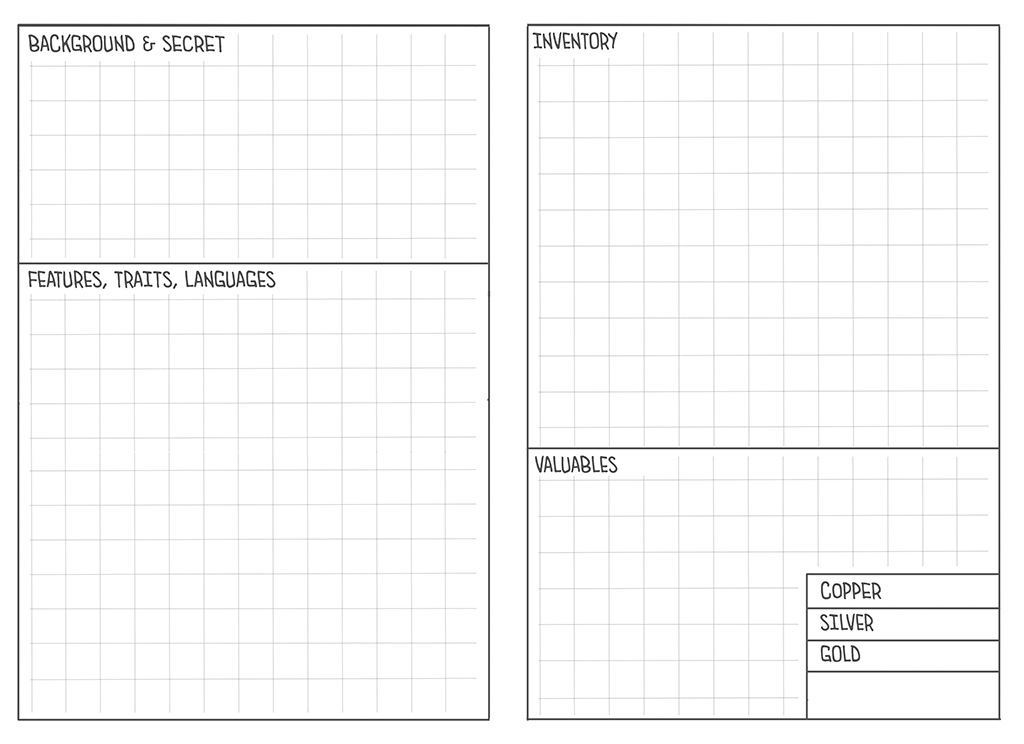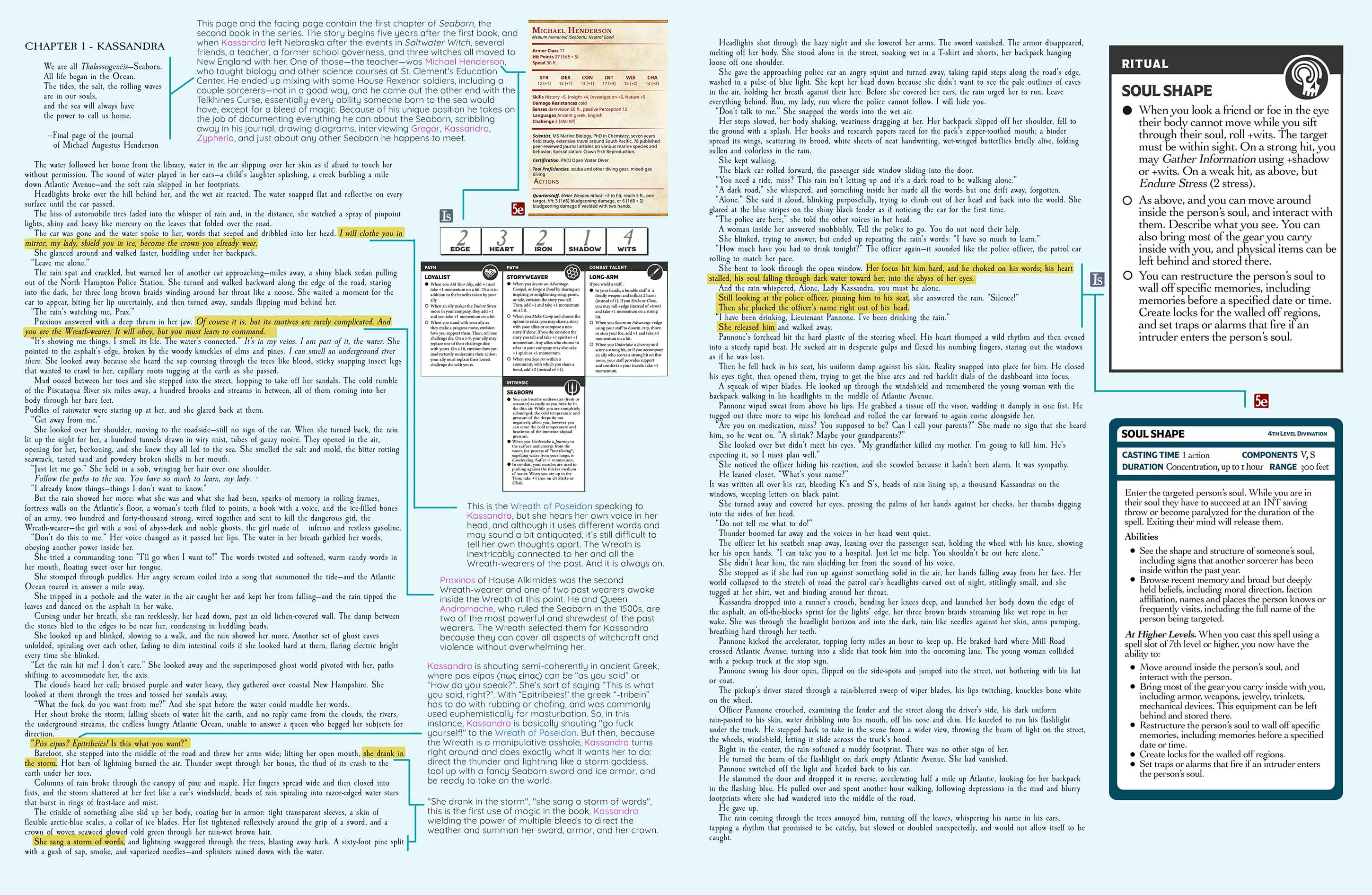Magic, the Three-Worlds Interpretation
August 15, 2021
A teaser page from a Book of Seaborn Lore I'm creating, mostly from the perspective of the fictional lore master himself, Michael Henderson. This is part of a long-running game design project I have going.

Meet Lyle...
July 30, 2021
Meet Lyle. Lyle is a Bane Tangle, sometimes called a Laminaria, which means he’s more like sentient, moderately aggressive, bipedal kelp than any reptile he may appear to resemble. You call him "Lyle the 'dile" and he will seriously blow a holdfast, and probably wipe the intertidal zone with you. On the weekends he enjoys surfing--as long as dweebs don't snake the waves. And Poseidon help them if they do. (2.5 hours in Art Rage 6 and Photoshop CC 2021)


Playing with a custom D&D 5e character sheet
April 12, 2021
Just a little something I put together in Photoshop. Here's the front. The back has a lot of room for info, magic, inventory, track your coppers, silver, and gold.
Download in PDF (both pages), Front, Back
Use the links above to download the full size versions.
FRONT:

BACK:

Thinking about D&D 5e, difficulty class, saves, and using Apocalypse World's ternary dice outcome
April 10, 2021
There are some surprising benefits when you attempt to mod D&D 5e to use Apocalypse World style dice mechanics. The core PbtA (Powered by the Apocalypse) mechanic is a 2d6 roll with three outcomes, 10+ is a strong hit, 7-9 is a weak hit or a hit with complications, and 6- is a miss with an appropriate GM move (something bad), and this drives how well or poorly a character does when faced with a challenge, how a gnoll gets in 12 HP damage without ever getting its own combat turn, and how a character can fail spectacularly—and learn from the mistake.
In Apocalypse World, like D&D, you roll + ability modifier—called “stats” in many PbtA games. Ignore the differences in scope and theme for our purposes in this exploration. Think of Apocalypse World’s stats, Cool, Hard, Hot, Sharp, and Weird in the same way you think about D&D’s ability modifiers for Strength, Dexterity, Constitution, Intelligence, Wisdom, and Charisma.
Using Paul Gestwicki's post about Comparing the dice of D&D and PbtA with Math (see the link below) we can represent very similar dice mechanics with a d20:
Ternary Outcome with a d20: strong hit: 18+, weak hit/partial success: 10-17, miss: 9- (9 or less)
Add your STR modifier to the roll, and that’s you swinging your sword at the gnoll captain.
Okay, that’s interesting, but what’s this I hear about no difficulty class (DC), no saving throws, no initiative in combat, and no combat turns for monsters/NPCs?
Yup. Your players are the protagonists of this collaborative story, and their abilities alone will determine their success, partial success, or failure. There’s no need for an additional difficulty threshold to jump over. Or think of it this way: we’ve ditched the binary success / failure outcome, and now that we have three outcomes in the mix, with the dice rolls skewed toward the middle bucket, success with consequences, we don’t need a separate bar for difficulty.
There’s no initiative because there are no combat turns in the traditional sense. Sure, the group will go around and let the DM know what they’re doing against the band of gnoll guards—“I stride forward with my sword out, heading for the one on the right”, “I’m going to cast firebolt—gesturing fluidly and calling on the elements”. The important concept is that the gnolls do not ever get their own combat turns. They do damage, cast spells, hit a player character with a crossbow bolt when the players fail a roll or succeed with a complication/consequence (You can put money on that “consequence” being damage when you roll badly during combat). Going all the way with PbtA, the DM does not have to roll any dice at all. (BTW, “Going all the way with PbtA” might be a good slogan to have on a con shirt. You're welcome). You can and probably should have the players roll the D6s and D12s for the gnoll damage rolls.
Try this:
Instead of Initiative, characters entering a combat situation must roll to keep their courage up. In most cases, every new fight can potentially end badly for a character, and unless they are psychos, there is going to be some trepidation, rapid strategizing, a hollow feeling in the stomach that’s your system telling you this might not go well for you. Rolling a failure in this case (on the approach; we haven’t even entered the fray yet) means you stopped dead in your tracks with the gnawing idea that maybe you’re not ready for this—or you have a bad feeling about these bugbears. Why aren’t they afraid of us? Are they protecting something or someone, and maybe they’ve already resigned themselves to death before fleeing—makes them more dangerous? Weak hits and misses make great opportunities for developing the fiction around the encounter, and adding to the entire story. Instead of just another seemingly random encounter with some bugbears, it becomes “that time we ran into a group of mama bears—a pack of bugbear mothers with their brood in tow, and they were willing to defend the young bugbears to the death, baring their teeth, threatening us. We just held up open hands and backed off until they had passed by”. Fiction first. The bugbear mama bears is a much better tale, a memorable tale. A random encounter with a random group bugbears is soon forgotten.
This also gives you, the DM, an opportunity to think about impending combat in new ways—anytime the characters approach a dangerous situation, a room full of powerful monsters, or even one large monster—let’s say a dragon. Take a minute to think about how this would play out in reality. There is no way your player characters are going to get close enough to swing a broadsword at a dragon without the firebreather getting in two or more attacks first. That’s reality. It doesn’t matter how powerful these characters are. Unless you have superhuman speed, or you can wade through a wall of supernatural fire, or you happen to find the dragon asleep, the characters will have to endure—survive—several armor-melting furnace blasts before they can get an attack in. You have an opportunity to make monsters far more powerful if necessary.
Where does this leave armor class? With this change in the core game mechanic—success, weak hit, or failure rolls are driven by the character’s Strength or Dexterity modifiers, ignoring the defender’s armor class or ability to avoid a hit. The armor becomes part of the fiction—on a miss or weak hit, the armor “held up against the sword blade” or “lost a few scales with the impact”. Ideally, your armor would reduce damage, but I haven't given changes to AC enough thought for an elegant solution. We'll have to come back to AC.
No saving throws? Sounds good. Let’s say you cast Poison Spray, which reads—this is from the 5e SRD:
You extend your hand toward a creature you can see within range and project a puff of noxious gas from your palm. The creature must succeed on a Constitution saving throw or take 1d12 poison damage.
So, what do we do about the saving throw? With the new mechanism, all spells require a roll—no exceptions, and that covers the save or fail-to-save mechanic. In this case, a 10-17 partial success means the target probably takes half of the 1d12 poison damage and you, the caster who is out of melee range, also takes something, maybe some backspray from the spell, a caustic cloud that you breathe in and now you cannot cast spells with a vocal component for two turns? On an 18+ you spray poison like a freakin’ pro with full 1d12 damage, and 9- means you botched the whole thing, no poison, no attack, and maybe even a side-effect for you to chew on—or a spell coming at you from their mage. Crap! Duck, you fool!
How do experience points/milestones work with this new way of doing things?
I would lift this process right out of Apocalypse World. (This method is also used in PbtA games like Dungeon World, Monster of the Week, Monsterhearts, City of Mist, and more). The idea is that there are a number of open slots, circles, squares, usually 3 to 5 on your playbook (character sheet), and when a player fails a roll (9 or below in this context) they mark experience. The PbtA way is that characters learn from their mistakes, and after they fill in the final mark for experience or improvement, they “level up”, they get to increase a trait, add a skill, become better at things that need improvement. What I especially like about this is that as the DM/MC/GM you get to say “mark experience” when a player rolls poorly, which takes a little bit of the sting out of the damage you’re about to bring. Not really, but it’s still cool. What it does do is subtly adjust the perception of a "night of bad rolls" to a "night of bad rolls, but I came out of that mess with a new feat."
There, that's my first pass at using Apocalypse World's beautiful dice mechanics in D&D 5e—while allowing players to keep their beloved d20.
NOTES:
Paul Gestwicki's Blog: Comparing the dice of D&D and PbtA with Math, June 15, 2020
http://paulgestwicki.blogspot.com/2020/06/comparing-dice-of-d-and-pbta-with-math.html#:~:text=On%202d6%2C%20there%20is%20a,chance%20of%20a%20full%20success.
The magic in Seaborn Chapter 1... and Mr. Henderson
November 1, 2020
This 2-page spread contains the complete chapter with highlighted magical events along with a defined NPC stat block for Michael Henderson for both Dungeons & Dragons 5e and Ironsworn. The spell/ritual Soul Shape is included for both as well.
Full size link:
https://www.dropbox.com/s/bs0p9f3cenrf3oq/SeabornChapter1-ChrisHoward_2PageSpread.jpg?dl=0

Truths about the Seaborn World - 2 page spread
October 21, 2020
Truths about the Seaborn World 2-page spread in the Ironsworn style, with Kassandra in black and white, using the same categories plus one extra for the army of the drowned dead. They need their own.
Here's the Dropbox link to the full size page:
https://www.dropbox.com/s/mnsq9l9rxjbfkiz/SeabornRefGuideforTRPG_ChrisHoward_2020_Vol1_01_rev14-3.jpg?dl=0
